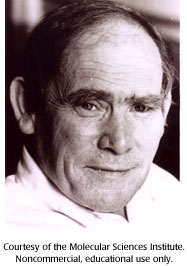Concept 21 RNA is an intermediary between DNA and protein.


 Paul Zamecnik developed a cell-free extract that he and Mahlon Hoagland used to study protein synthesis. They identified tRNA as the adaptor predicted by Francis Crick in his Central Dogma. Sydney Brenner showed that mRNA was the unstable intermediate that carried the message from DNA to the ribosomes.
Paul Zamecnik developed a cell-free extract that he and Mahlon Hoagland used to study protein synthesis. They identified tRNA as the adaptor predicted by Francis Crick in his Central Dogma. Sydney Brenner showed that mRNA was the unstable intermediate that carried the message from DNA to the ribosomes.
Sydney Brenner (1927–2019)

Sydney Brenner was born in Germiston, South Africa. At the age of 15, Brenner won a scholarship to the University of the Witwatersrand in South Africa. At the time, the South African university system was underdeveloped and Brenner did a lot of independent research and self-teaching on the subject of molecular biology. When he graduated from Witwatersrand, there was no graduate research program. Brenner applied to and went to Oxford and started graduate work on bacteriophage.
In 1953, Brenner was one of a group invited to Cambridge University to view Watson and Crick's DNA structure. This became the first of many meetings and collaborations Brenner had with Watson, and even more so with Crick.
In 1954, Brenner received his doctorate degree and returned to lecture at the University of the Witwatersrand. By now he was working on the problem of the genetic code and the role of RNA in information transfer. In 1956, Brenner sent a paper to members of the RNA tie club On the Impossibility of All Overlapping Triplet Codes - an elegant proof that used statistics and amino acid protein sequences to show that three nucleotides code for one amino acid. That same year, Francis Crick, who was also interested in the problem of information transfer, helped Brenner get a research position at the Medical Research Council in Cambridge.
In 1957, Brenner, Seymour Benzer, Francis Crick, and Leslie Barnett published a paper in Nature on the fine mapping of mutations in phage. By correlating the genetic mutations with changes in the amino acid sequence, they were able to prove colinearity between the genetic message and the protein product. Brenner then moved onto the problem of how the information was transferred between DNA and protein. In 1960, Brenner, François Jacob, and Matthew Meselson designed and worked on another series of experiments establishing the existence and function of messenger RNA.
In the late 60's, Brenner became interested in the problem of development, especially that of the nervous system. In 1968, having decided against Drosophila melanogaster as too complex, Brenner chose Caenorhabditis elegans as a model organism for study. C. elegans is now a research field onto itself, and in 1998, was the first multi-cellular organism to have its complete genome sequenced.
In the 90's, Brenner chose yet another organism, Fugu rubripes, the Japanese puffer fish. Although it has about as many genes as humans, the puffer fish does not have as much "junk" DNA. In 1989, Brenner and colleagues initiated the Fugu rubripes (Japanese pufferfish) genome sequencing project.
In 1998, with a donation from tobacco giant Phillip Morris, Brenner established and is the director of the Molecular Science Institution (MSI) in Berkeley, California. A non-profit organization, part of the role of the MSI is to process the flood of information from the various genome sequencing projects.
Brenner likes travelling and good wine and wrote an opinion column called Loose Ends for the journal Current Biology.
Brenner shared the 2002 Nobel Prize in Physiology or Medicine with colleagues John Sulston and Robert Horvitz. All three made major contributions in the field of developmental biology using the model organism Caenorhabditis elegans.


Mahlon Hoagland's father was a research scientist, and founded the Worcester Foundation for Experimental Biology, the institution where, among other things, the birth control pill was developed.

Hoagland and Zamecnik were identifying the molecules and the energy requirements of protein synthesis reactions. Would it have been easier if they had known about Francis Crick's adapter hypothesis?
 DNA and proteins are key molecules of the cell nucleus.
DNA and proteins are key molecules of the cell nucleus. One gene makes one protein.
One gene makes one protein. A gene is made of DNA.
A gene is made of DNA. Bacteria and viruses have DNA too.
Bacteria and viruses have DNA too. The DNA molecule is shaped like a twisted ladder.
The DNA molecule is shaped like a twisted ladder. A half DNA ladder is a template for copying the whole.
A half DNA ladder is a template for copying the whole. RNA is an intermediary between DNA and protein.
RNA is an intermediary between DNA and protein. DNA words are three letters long.
DNA words are three letters long. A gene is a discrete sequence of DNA nucleotides.
A gene is a discrete sequence of DNA nucleotides. The RNA message is sometimes edited.
The RNA message is sometimes edited. Some viruses store genetic information in RNA.
Some viruses store genetic information in RNA. RNA was the first genetic molecule.
RNA was the first genetic molecule. Mutations are changes in genetic information.
Mutations are changes in genetic information. Some types of mutations are automatically repaired.
Some types of mutations are automatically repaired.